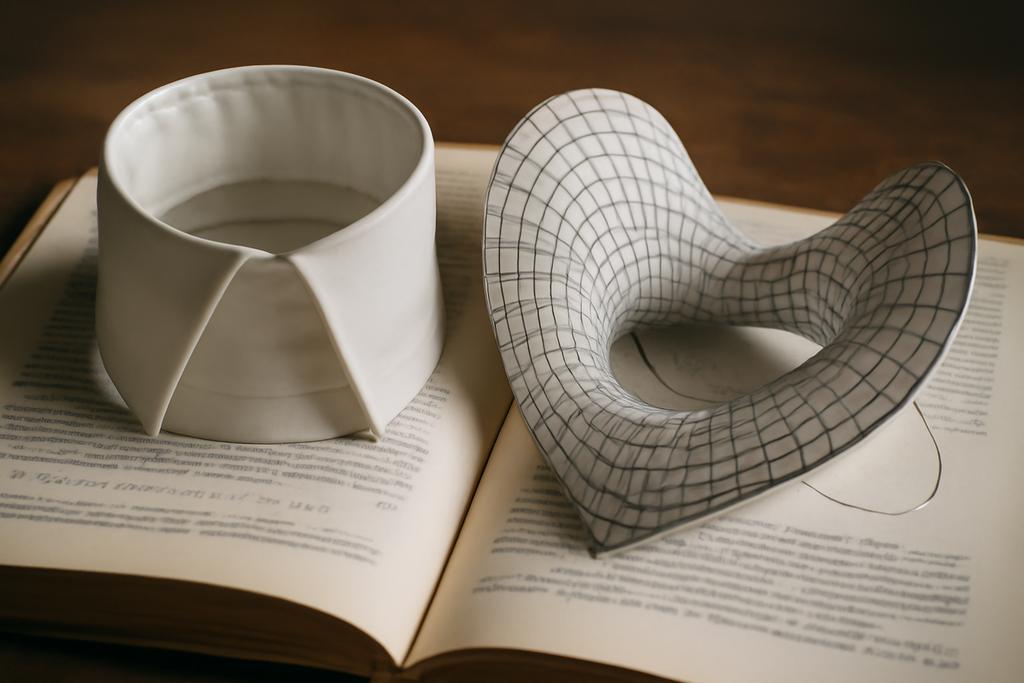The collar theorem has always sounded like a tailor’s joke in a mathematician’s mouth: there’s a uniform, snug tube you can wrap around a loop on a surface, and its size depends only on how long the loop is and how the surface curves—not on the whole surface itself. In the 1970s, that idea anchored a powerful intuition about shapes that curve in the plane and beyond. Now, Peter Buser of EPFL and José M. Rodríguez of Universidad Carlos III de Madrid push the collar idea into wilder terrain: complete, noncompact surfaces where ends stretch to infinity. Their work, carried out at two strong mathematical communities, shows you can still sew a collar around nontrivial geodesics with a width dictated by curvature bounds and the geodesic’s length, without needing the surface to be compact. It’s as if the tailor’s tape measure expands to cover a horizon instead of a single garment.
This study, conducted in part at EPFL in Switzerland and UC3M in Spain, is led by Peter Buser and José M. Rodríguez. The authors don’t just transplant a compact-surface theorem to a bigger stage; they refine the geometric toolkit you need to do it. They extend Toponogov-style triangle comparisons—an elegant way to compare curved triangles to their flat or hyperbolic counterparts—to settings where the surface isn’t neatly bounded. They also add a new thread to the tapestry: a theorem about the level sets of distance functions that guarantees certain distance contours remain well-behaved (rectifiable and, in many cases, Lipschitz) even on infinite, tubular geometries. The result is a sturdier, more versatile collar theorem that travels with the surface’s ends.
In a sense, the paper asks: what happens to the geometry of a surface when you drill out a noncompact world, keep the curvature bounded below, and still insist on nice collars around meaningful loops? The answer, surprisingly tidy, is that you still get uniform-width neighborhoods around nontrivial geodesics—a result with implications for how we think about the shape of space in both pure mathematics and the ways we model networks and surfaces in the wild. The authors’ achievement is to show that a classical, beautifully geometric phenomenon survives the leap from compact worlds to infinite horizons.
The Collar Theorem, Reimagined for the Infinite
At its core, the collar theorem says: around every simple closed geodesic on a compact surface, there’s a tubular neighborhood, the collar, whose width is controlled by the geodesic’s length and the curvature bound below. Crucially, that width doesn’t depend on the particular surface you’re looking at. Randol and later Chavel–Feldman laid out the precise inequalities in the compact setting, and Buser’s prior work extended the theme, emphasizing how the collar’s existence folds into the surface’s global geometry. The new paper extends this to complete, noncompact surfaces by proving a sharp inequality for the collar width dγ that only depends on the curvature bound (K ≥ −k^2) and the geodesic length L(γ). In symbols, they show that dγ is bounded below by a universal expression tied to L(γ) and the curvature bound, regardless of whether the surface is compact or not.
That statement isn’t merely a bookkeeping victory. It reframes how we think about ends and infinity: even when a surface stretches out to infinity, holes, loops, and the spaces around them still insist on a predictable, uniform pocket of space surrounding them. The collar doesn’t vanish at the edge of the world; it remains a robust geometric witness to the loop’s presence. The researchers also obtain a similar separation principle for two nontrivial collars: if you have two disjoint, nonintersecting simple closed geodesics, their collars stay apart by a quantified distance. These two results—one about a single collar and one about the distance between collars—together paint a coherent picture of how curvature tames infinity in a precisely measurable way.
In the language of the paper, the key theorems (generalizing Theorem 1.1 for complete surfaces and related inequalities) rely on a careful topological and geometric decomposition of the surface into building blocks like generalized funnels, generalized cusps, and generalized Y-pieces. The authors show that even when the surface isn’t compact, you can still piece together its geometry from these blocks, and the collars around nontrivial geodesics behave predictably across those pieces. The result is a unifying narrative: the collar is not a fragile artifact of compactness but a fundamental feature of the geometry of curved surfaces, resilient enough to survive passage to infinity.
Tools from a Gentle Geometry Arsenal
To reach these results, the authors lean on a classic set of tools with a modern twist. Toponogov’s triangle comparison theorem is the backbone: it lets you compare a curved triangle with a model triangle in hyperbolic space, preserving side lengths while controlling angles. The extension of that idea to noncompact scenarios—where the ambient surface may have infinite extent—requires new angle and side comparison results, especially for right-angled triangles. The paper devotes a careful section to laying out these extensions, filling gaps in the literature and showing how these comparisons still yield rigorous inequality chains that propagate through the collar estimates.
Another crucial instrument is the decomposition of complete surfaces into Y-pieces, funnels and half-planes. In the compact world, this decomposition is a standard tool for understanding the global geometry; in the noncompact setting, it becomes a way to organize the infinite into comprehensible, finite-building-block logic. Once the surface is broken into these pieces, the collars can be analyzed piece by piece, then reassembled with control over how the pieces fit together. The authors prove that in this broader canvas, the collar widths can be compared across different regions of the surface, and even when two geodesics sit in different Y-pieces or funnels, their collars maintain the promised separation.
A compact appendix on the level sets of distance functions rounds out the methodological package. The level sets of distance to a closed set—think of the contours at a fixed distance from a geodesic boundary—are shown to be rectifiable curves in broad generality, and Lipschitz regularity holds in the thin-cylinder regime. That rectifiability ensures you can talk meaningfully about the “boundaries” of distance neighborhoods, enabling the collar arguments to ride on well-behaved geometric curves rather than wild, fractal frontiers. It’s a quiet but essential technical backbone: the geometry has to be tame enough to measure.
End-Parts, Thin Ends and the Geometry of Infinity
The paper spends considerable time on what happened to collars when a surface has ends that behave like infinite cylinders. The collar theorem in the infinite setting isn’t just about wrapping a band around a loop; it’s about ensuring that the loop’s neighborhood doesn’t vanish or overlap in pathological ways as you slide off into the end. The authors address this by constructing a precise taxonomy of ends—funnels, cusps, half-planes, and Y-pieces—and showing that even in a noncompact universe, the local collar data attached to a simple closed geodesic remains robust. They show, in particular, a version of the collar theorem that holds for thin ends and for cylinders bounded by geodesics. This is not just a clever trick; it’s a crucial bridge between local curvature control and global topological structure.
The notion of end-thickness—the idea that a region around a loop remains wide enough to avoid degeneracy even as you approach infinity—emerges as a central theme. The collar constant, determined by L(γ) and the curvature bound, anchors a region of space that persists no matter how far the surface extends. The authors also examine how two collars interact when their geodesics are not homotopic, deriving lower bounds on the distance between the loops that echo the compact-case results but now in the open-ended landscape. In short, infinity doesn’t erase structure; it reshapes it in a controlled, predictable way.
One particularly appealing thread is the treatment of “cactus arms,” curious protrusions that can appear in thin ends. The authors show that in highly thin regions with a small boundary length, any loop freely homotopic to the boundary must have a length bounded below by a universal constant. This technical insight prevents the geometry from sprouting arbitrary short circuits in the collar’s neighborhood, preserving the integrity of the trench-like regions the collar defines. It’s a reminder that even in a universe without edges, geometry loves to enforce patience on the shortest loops.
Why This Matters Beyond Pure Math
Why should a popular reader care about a collar theorem for complete surfaces? Because it’s a striking example of how a deep, abstract geometric principle can survive and even thrive when you remove comforting assumptions like compactness. The result has a simple, human intuition: around a meaningful loop on a curved surface, you can carve out a uniform, collar-like region whose width is dictated by the loop and the curvature, not by the rest of the surface. That notion—local structure constraining global possibilities—appears across physics, computer graphics, and materials science, where rough geometries abound and yet predictable local neighborhoods matter for stability and behavior.
The mathematical apparatus—Toponogov-style comparison, surface decompositions into Y-pieces and funnels, and a careful theory of distance-level sets—also has implications beyond pure geometry. The rectifiability of distance sets means that, in principle, one can analyze how a surface separates space in a controlled way, a fact that plays nicely with numerical approximations and geometric modeling. The authors’ careful attention to infinite cylinders and ends shows how global topology can be tamed by curvature bounds, a philosophy that resonates with how scientists think about systems that extend to large scales without losing local predictability.
Finally, the paper situates its results in a living conversation about collars in higher dimensions and in related geometric structures, including Hitchin representations and complex hyperbolic manifolds. While the results are technically grounded in two-dimensional Riemannian geometry, the ideas ripple outward: the notion that ends of a space can be managed with uniform local control, and that comparisons with model geometries can unlock global structure. It’s a narrative about geometry’s stubborn consistency—the way a well-cut collar can keep a tunic’s edges neat, even as the garment expands to cover a horizon.
A Clear Path Forward: Implications and Open Questions
The authors’ achievements spark several natural directions for future exploration. One is a broader generalization to higher dimensions. The collar phenomenon has analogs in complex hyperbolic geometry and in Hitchin representations, where the geometry of boundaries and ends interacts with more algebraic structures. Early work in that vein—e.g., collar lemmas adapted to Hitchin representations—suggests that the underlying principle is robust across contexts: near a core loop or boundary, the ambient geometry imposes a rigid, predictable neighborhood. The current paper strengthens the base by showing that, in two dimensions, you don’t need compactness to keep the collar intact.
Another open thread concerns the practical calculus of distance sets in noncompact spaces. The appendix on level sets elevates a familiar distance-field concept to a general, rectangles-and-Lipschitz world. How these results translate into computational algorithms for simulating curved surfaces—think physics engines, digital sculpting, or geometric data analysis—could be a fruitful avenue, especially where surfaces model real-world phenomena that are effectively infinite or open-ended.
As with many advances in geometry, the deeper significance may be indirect: by sharpening our understanding of how local curvature governs global shape, the authors illuminate how subtle constraints shape everything from the behavior of waves on a manifold to the stability of networks laid over curved spaces. The collaboration between EPFL and UC3M highlights how shared mathematical curiosity—pushed across borders and disciplines—can yield insights that feel both precise and poetic: a collar that holds, a boundary that clarifies, and a horizon that remains approachable rather than abstract.
The work also nods to a long tradition of decomposing complex surfaces into manageable pieces. In noncompact scenarios, the ability to parse a surface into funnels, cusps, Y-pieces, and half-planes is more than a technique—it’s a philosophy: even when the territory is unbounded, you can assemble a coherent geometric story from well-understood chapters. The collar theorems show that those chapters don’t wander off the page; they keep their margins neat, their widths bounded, and their distances measurable. That’s geometry as a reliable compass, not a mysterious force.
As the authors remind readers, there are still many fertile frontiers. The higher-dimensional collar generalizations and the interplay with representation theory and complex geometry remain active and rich domains. For curious readers who like to ride the edge between intuition and exact proof, this work offers both a clear, elegant theorem and a deeply human sense of how mathematics extends a familiar idea—collars around loops—into an inexhaustible landscape of shapes.
The paper is a reminder that even on surfaces that never close, the geometry we prize can still be tamed, measured, and understood. The collar is more than a protective ring; it’s a lens that makes infinity legible. And in a world where surfaces and spaces continually collide with real-world questions—design, physics, computer graphics, and more—that clarity is, indeed, worth stitching into the fabric of our mathematical imagination.
Lead researchers and institutions: This work was conducted by Peter Buser of École Polytechnique Fédérale de Lausanne (EPFL) and José M. Rodríguez of Universidad Carlos III de Madrid, and it stands on the collaborative bridge between these two mathematical communities.










